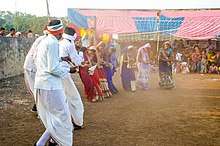Korku people
The Korku are an Adivasi ethnic group predominantly found in the Khandwa, Burhanpur, Betul and Chhindwara districts of Madhya Pradesh and adjoining areas near the Melghat Tiger Reserve of Maharashtra. They speak the Korku language, which is a member of the Munda languages and is written using Devanagari. They are classified as a Scheduled Tribe by the Indian government.[2]
.jpg) A Korku family living near Melghat Tiger Reserve, Maharastra | |
| Total population | |
|---|---|
| 995,399 (2011 census)[1] | |
| Regions with significant populations | |
| Madhya Pradesh | 730,847[1] |
| Maharastra | 264,492[1] |
| Languages | |
| Korku •Marathi •Hindi | |
| Religion | |
| Hinduism | |
Etymology
The name ‘Korku’ is originated from two terms ‘Koro’ and ‘Ku’ whereas ‘Koro’ means person and ‘Ku’ means alive. Combinely, the two words ‘Koro and Ku’ are defined as the alive member. [3] The Korkus are a Munda tribe and live near a Dravidian-speaking tribe — the Gonds. The Korku people are initially believed to be a hunter-gatherer community who dwelt in the forests of the Satpura Range on both sides of the Tapti River.[4]
Dwelling
The Korku tribe lives in small groups of huts made of grass and wood. Every household has elevated stage like structure in the front side of the house. This elevated stage is used as a storage space of farm produce such as cattle feed. They socially consume liquor made from the flowers of the Mahua tree which is prepared in almost all the houses. Predominantly, a rural-based community with 97% living in rural areas,[1] Korkus are primarily cultivators.[5]
Whilst they share the love of the forests with the Gonds, they are also excellent agriculturists and Korkus in Bhainsdehi tahsil of Betul district of Madhya Pradesh have pioneered the cultivation of potato and coffee. In their traditional festivals of Hari and Jitori, they celebrate a month long planting campaign. In this way they combat malnutrition and environmental degradation.[5]
The community is the home to a unique and distinct culture, possesses a rich heritage of age old traditional systems more pertinently in terms of indigenous knowledge, beliefs, customs and social system. Traditional representative body of the society known as ‘Korku Panchayat’ is found in many villages. Headed by a chief known as Patel, other members in the Panchayat include Padihar (priest), Kotwar (Chaukidar) and ten to twelve older male members of the community known as Panch. It plays a decisive role during traditional occasions mainly in festivals, marriages and intra- and inter-village conflict resolutions. Known for poverty, hunger, malnutrition, mass-scale exploitation by moneylenders and traders, the community confronts with numerous socio-economic challenges in the day-to-day life partly due to the poor natural resource bases. Agriculture though the primary source of livelihoods for most of the community members, many of them earn their livelihoods seasonally employed as agricultural labourers.

See also
References
- "Individual Scheduled Tribe Primary Census Abstract Data and its Appendix". Indian Census. Government of India. Retrieved 23 October 2017.
- "Korku | people". Encyclopedia Britannica. Retrieved 23 October 2017.
- Biswas, Ranjan Kumar (March 2017). "Changing educational scenario of a scheduled tribe of Madhya Pradesh". International Journal of Multidisciplinary Research and Development. 4 (3): 250.
- 1938-, Deogaonkar, S. G. (Shashishekhar Gopal) (1990). The Korku tribals. Deogaonkar, S. S. (Shailaja Shashishekhar), 1942-. New Delhi, India: Concept Pub. Co. ISBN 8170222974. OCLC 23830696.CS1 maint: numeric names: authors list (link)
- Stephen, Fuchs (1988). The Korkus of the Vindhya Hills. New Delhi, India: Inter-India Publications. ISBN 9788121002035. OCLC 20222354.
![]()